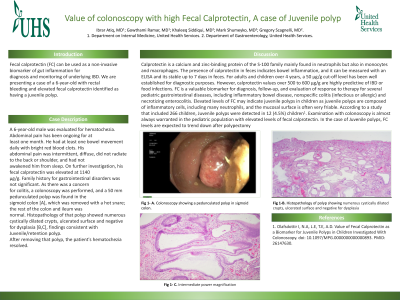Back


Poster Session B - Monday Morning
Category: Colon
B0142 - Value of Colonoscopy With High Fecal Calprotectin: A Case of Juvenile Polyp
Monday, October 24, 2022
10:00 AM – 12:00 PM ET
Location: Crown Ballroom

Has Audio

Ibrar Atiq, MD
United Health Services- Wilson Hospital
Johnson City, NY
Presenting Author(s)
Ibrar Atiq, MD1, Gowthami Ramar, MD2, Khaleeq Siddiqui, MD2, Mark Shumeyko, MD3, Gregory Scagnelli, MD4
1United Health Services- Wilson Hospital, Johnson City, NY; 2United Health Services Hospital, Johnson City, NY; 3UHS Wilson Medical Center, Johnson City, NY; 4United Health Services Hospitals, Binghamton, NY
Introduction: Fecal calprotectin (FC) can be used as a non-invasive biomarker of gut inflammation for
diagnosis and monitoring of underlying IBD. We are presenting a case of a 6-year-old with rectal
bleeding and elevated fecal calprotectin identified as having a juvenile polyp.
Case Description/Methods: A 6-year-old male was evaluated for hematochezia. Abdominal pain has been ongoing for at
least one month. He had at least one bowel movement daily with bright red blood clots. His
abdominal pain was intermittent, diffuse, did not radiate to the back or shoulder, and had not
awakened him from sleep. On further investigation, his fecal calprotectin was elevated at 1140
μg/g. Family history for gastrointestinal disorders was not significant. As there was a concern
for colitis, a colonoscopy was performed, and a 50 mm pedunculated polyp was found in the
sigmoid colon [A], which was removed with a hot snare; the rest of the colon and ileum was
normal. Histopathology of that polyp showed numerous cystically dilated crypts, ulcerated surface and negative for dysplasia [B,C], findings consistent with Juvenile/retention polyp.
After removing that polyp, the patient's hematochezia resolved.
Discussion: Calprotectin is a calcium and zinc-binding protein of the S-100 family mainly found in neutrophils
but also in monocytes and macrophages. The presence of calprotectin in feces indicates bowel
inflammation, and it can be measured with an ELISA and its stable up to 7 days in feces. For
adults and children over 4 years, a 50 μg/g cut-off level has been well established for
diagnostic purposes. However, calprotectin values over 500 to 600 μg/g are highly predictive of
IBD or food infections. FC is a valuable biomarker for diagnosis, follow-up, and evaluation of
response to therapy for several pediatric gastrointestinal diseases, including inflammatory bowel
disease, nonspecific colitis (infectious or allergic) and necrotizing enterocolitis. Elevated levels
of FC may indicate juvenile polyps in children as juvenile polyps are composed of inflammatory
cells, including many neutrophils, and the mucosal surface is often very friable. According to a
study that included 266 children, Juvenile polyps were detected in 12 (4.5%) children.
Examination with colonoscopy is almost always warranted in the pediatric population with
elevated levels of fecal calprotectin. In the case of Juvenile polyps, FC levels are expected to
trend down after polypectomy.

Disclosures:
Ibrar Atiq, MD1, Gowthami Ramar, MD2, Khaleeq Siddiqui, MD2, Mark Shumeyko, MD3, Gregory Scagnelli, MD4. B0142 - Value of Colonoscopy With High Fecal Calprotectin: A Case of Juvenile Polyp, ACG 2022 Annual Scientific Meeting Abstracts. Charlotte, NC: American College of Gastroenterology.
1United Health Services- Wilson Hospital, Johnson City, NY; 2United Health Services Hospital, Johnson City, NY; 3UHS Wilson Medical Center, Johnson City, NY; 4United Health Services Hospitals, Binghamton, NY
Introduction: Fecal calprotectin (FC) can be used as a non-invasive biomarker of gut inflammation for
diagnosis and monitoring of underlying IBD. We are presenting a case of a 6-year-old with rectal
bleeding and elevated fecal calprotectin identified as having a juvenile polyp.
Case Description/Methods: A 6-year-old male was evaluated for hematochezia. Abdominal pain has been ongoing for at
least one month. He had at least one bowel movement daily with bright red blood clots. His
abdominal pain was intermittent, diffuse, did not radiate to the back or shoulder, and had not
awakened him from sleep. On further investigation, his fecal calprotectin was elevated at 1140
μg/g. Family history for gastrointestinal disorders was not significant. As there was a concern
for colitis, a colonoscopy was performed, and a 50 mm pedunculated polyp was found in the
sigmoid colon [A], which was removed with a hot snare; the rest of the colon and ileum was
normal. Histopathology of that polyp showed numerous cystically dilated crypts, ulcerated surface and negative for dysplasia [B,C], findings consistent with Juvenile/retention polyp.
After removing that polyp, the patient's hematochezia resolved.
Discussion: Calprotectin is a calcium and zinc-binding protein of the S-100 family mainly found in neutrophils
but also in monocytes and macrophages. The presence of calprotectin in feces indicates bowel
inflammation, and it can be measured with an ELISA and its stable up to 7 days in feces. For
adults and children over 4 years, a 50 μg/g cut-off level has been well established for
diagnostic purposes. However, calprotectin values over 500 to 600 μg/g are highly predictive of
IBD or food infections. FC is a valuable biomarker for diagnosis, follow-up, and evaluation of
response to therapy for several pediatric gastrointestinal diseases, including inflammatory bowel
disease, nonspecific colitis (infectious or allergic) and necrotizing enterocolitis. Elevated levels
of FC may indicate juvenile polyps in children as juvenile polyps are composed of inflammatory
cells, including many neutrophils, and the mucosal surface is often very friable. According to a
study that included 266 children, Juvenile polyps were detected in 12 (4.5%) children.
Examination with colonoscopy is almost always warranted in the pediatric population with
elevated levels of fecal calprotectin. In the case of Juvenile polyps, FC levels are expected to
trend down after polypectomy.

Figure: (A, a pedunculate polyp) (B, numerous cystically dilated crypts, ulcerated surface and negative for dysplasia) (C, Intermediate power magnification)
Disclosures:
Ibrar Atiq indicated no relevant financial relationships.
Gowthami Ramar indicated no relevant financial relationships.
Khaleeq Siddiqui indicated no relevant financial relationships.
Mark Shumeyko indicated no relevant financial relationships.
Gregory Scagnelli indicated no relevant financial relationships.
Ibrar Atiq, MD1, Gowthami Ramar, MD2, Khaleeq Siddiqui, MD2, Mark Shumeyko, MD3, Gregory Scagnelli, MD4. B0142 - Value of Colonoscopy With High Fecal Calprotectin: A Case of Juvenile Polyp, ACG 2022 Annual Scientific Meeting Abstracts. Charlotte, NC: American College of Gastroenterology.
